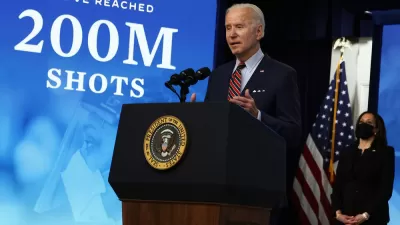With most of the nation in the coronavirus "red zone," the endgame to the pandemic in the U.S. is likely through achieving herd immunity, preferably through vaccinations, but the nation's top infectious disease expert has been changing the threshold.

"What portion of the population must acquire resistance to the coronavirus, either through infection or vaccination, for the disease to fade away and life to return to normal?" asks Donald G. McNeil Jr., a science and health reporter for The New York Times specializing in plagues and pestilences. Upon achieving that threshold, the chain of transmission of the virus is broken and herd immunity is established.
Since the start of the pandemic, the figure that many epidemiologists have offered has been 60 to 70 percent. That range is still cited by the World Health Organization and is often repeated during discussions of the future course of the disease.
In fact, our first post on coronavirus research (before the term was tagged) in May used the 60% to 70% threshold, as did the nation's top infectious disease expert, Anthony S. Fauci. However, "last week, in an interview with CNBC News, he said '75, 80, 85 percent,'" adds McNeil.
Asked about Dr. Fauci’s conclusions, prominent epidemiologists said that he may be proven right. The early range of 60 to 70 percent was almost undoubtedly too low, they said, and the virus is becoming more transmissible, so it will take greater herd immunity to stop it.
In a telephone interview the next day [Dec. 17], Dr. Fauci acknowledged that he had slowly but deliberately been moving the goal posts. He is doing so, he said, partly based on new science, and partly on his gut feeling that the country is finally ready to hear what he really thinks.
McNeil explained that early polling data showed an unwillingness among Americans to consider vaccines had influenced Fauci's decision to give the lower threshold for establishing herd immunity. Upon seeing an increase in the willingness of Americans to consider taking COVID-19 vaccines, he felt more emboldened to "nudge this up a bit, so I went to 80, 85.”
New coronavirus variants = more transmission
"Further complicating matters, there is a growing consensus among scientists that the virus itself is becoming more transmissible," adds McNeil. While the media has largely focused its attention on the U.K. strain, there are others as well.
A variant “Italian strain” with the mutation known as D614G has spread much faster than the original Wuhan variant. A newly identified mutation, sometimes called N501Y, that may make the virus even more infectious has recently appeared in Britain, South Africa and elsewhere.
A study from the London School of Hygiene and Tropical Medicine released Dec. 23 found the increased transmissibility of the U.K. variant reason to accelerate the rate of vaccinations, report New York Times correspondents Carl Zimmer and
The study found no evidence that the variant was more deadly than others. But the researchers estimated that it was 56 percent more contagious. On Monday, the British government released an initial estimate of 70 percent.
A new rule from the Centers for Disease Control and Prevention became effective Sunday (Dec. 27) night that requires all travelers from the U.K. to the U.S. to show proof of a negative COVID-19 test "no more than 3 days before your flight to the US from the UK departs. Make sure to be tested with a viral test (NAAT [Nucleic Acid Amplification] or antigen test) to determine if you are currently infected with COVID-19."
"The new rules were a reversal for the Trump administration, which initially told American airliners that the government would not require testing for travelers from Britain," reported the Times on Dec. 24.
Related in Planetizen:
-
Pandemic Endgame, May 18, 2020
Hat tip to Mike Allen of Axios.
Correspondent's note: The Times provides two versions of the source article – a long one and a short one. Linked below is the long one.
FULL STORY: How Much Herd Immunity Is Enough?

Alabama: Trump Terminates Settlements for Black Communities Harmed By Raw Sewage
Trump deemed the landmark civil rights agreement “illegal DEI and environmental justice policy.”

Planetizen Federal Action Tracker
A weekly monitor of how Trump’s orders and actions are impacting planners and planning in America.

The 120 Year Old Tiny Home Villages That Sheltered San Francisco’s Earthquake Refugees
More than a century ago, San Francisco mobilized to house thousands of residents displaced by the 1906 earthquake. Could their strategy offer a model for the present?

In Both Crashes and Crime, Public Transportation is Far Safer than Driving
Contrary to popular assumptions, public transportation has far lower crash and crime rates than automobile travel. For safer communities, improve and encourage transit travel.

Report: Zoning Reforms Should Complement Nashville’s Ambitious Transit Plan
Without reform, restrictive zoning codes will limit the impact of the city’s planned transit expansion and could exclude some of the residents who depend on transit the most.

Judge Orders Release of Frozen IRA, IIJA Funding
The decision is a victory for environmental groups who charged that freezing funds for critical infrastructure and disaster response programs caused “real and irreparable harm” to communities.
Urban Design for Planners 1: Software Tools
This six-course series explores essential urban design concepts using open source software and equips planners with the tools they need to participate fully in the urban design process.
Planning for Universal Design
Learn the tools for implementing Universal Design in planning regulations.
Jessamine County Fiscal Court
Caltrans
Institute for Housing and Urban Development Studies (IHS)
City of Grandview
Harvard GSD Executive Education
Toledo-Lucas County Plan Commissions
Salt Lake City
NYU Wagner Graduate School of Public Service





























